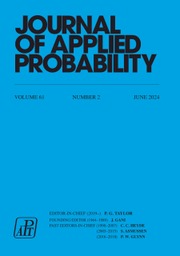Crossref Citations
This article has been cited by the following publications. This list is generated based on data provided by Crossref.
Jang, Jiwook
and
Dassios, Angelos
2011.
A Bivariate Shot Noise Hawkes Process for Insurance.
SSRN Electronic Journal,
Bacry, E.
Dayri, K.
and
Muzy, J. F.
2012.
Non-parametric kernel estimation for symmetric Hawkes processes. Application to high frequency financial data.
The European Physical Journal B,
Vol. 85,
Issue. 5,
Chavez-Demoulin, V.
and
McGill, J.A.
2012.
High-frequency financial data modeling using Hawkes processes.
Journal of Banking & Finance,
Vol. 36,
Issue. 12,
p.
3415.
Hardiman, Stephen J.
Bercot, Nicolas
and
Bouchaud, Jean-Philippe
2013.
Critical reflexivity in financial markets: a Hawkes process analysis.
The European Physical Journal B,
Vol. 86,
Issue. 10,
Herrera, Rodrigo
2013.
Energy risk management through self-exciting marked point process.
Energy Economics,
Vol. 38,
Issue. ,
p.
64.
Jang, Jiwook
and
Dassios, Angelos
2013.
A bivariate shot noise self-exciting process for insurance.
Insurance: Mathematics and Economics,
Vol. 53,
Issue. 3,
p.
524.
Dassios, Angelos
and
Zhao, Hongbiao
2013.
Exact simulation of Hawkes process with exponentially decaying
intensity.
Electronic Communications in Probability,
Vol. 18,
Issue. none,
Hardiman, Stephen J.
and
Bouchaud, Jean-Philippe
2014.
Branching-ratio approximation for the self-exciting Hawkes process.
Physical Review E,
Vol. 90,
Issue. 6,
Gresnigt, Francine
Kole, Erik
and
Franses, Philip Hans
2014.
Interpreting Financial Market Crashes as Earthquakes: A New Early Warning System for Medium Term Crashes.
SSRN Electronic Journal,
Huh, Yesol
2014.
Machines vs. Machines: High Frequency Trading and Hard Information.
SSRN Electronic Journal,
Ricci, Jason
2014.
Applied Stochastic Control in High Frequency and Algorithmic Trading.
SSRN Electronic Journal,
Filimonov, Vladimir
Bicchetti, David
Maystre, Nicolas
and
Sornette, Didier
2014.
Quantification of the high level of endogeneity and of structural regime shifts in commodity markets.
Journal of International Money and Finance,
Vol. 42,
Issue. ,
p.
174.
Chavez-Demoulin, V.
Embrechts, P.
and
Sardy, S.
2014.
Extreme-quantile tracking for financial time series.
Journal of Econometrics,
Vol. 181,
Issue. 1,
p.
44.
Dassios, Angelos
and
Zhao, Hongbiao
2014.
A Markov Chain Model for Contagion.
Risks,
Vol. 2,
Issue. 4,
p.
434.
Juncen, Li
Sheng, Gao
Yu, Zhao
Hao, Xu
Huacan, Pang
and
Zhiqing, Lin
2014.
Inferring links in cascade through hawkes process based diffusion model.
p.
471.
Zheng, Ban
Roueff, François
and
Abergel, Frédéric
2014.
Modelling Bid and Ask Prices Using Constrained Hawkes Processes: Ergodicity and Scaling Limit.
SIAM Journal on Financial Mathematics,
Vol. 5,
Issue. 1,
p.
99.
Grothe, Oliver
Korniichuk, Volodymyr
and
Manner, Hans
2014.
Modeling multivariate extreme events using self-exciting point processes.
Journal of Econometrics,
Vol. 182,
Issue. 2,
p.
269.
Wheatley, Spencer
Filimonov, Vladimir
and
Sornette, Didier
2014.
Estimation of the Hawkes Process with Renewal Immigration Using the EM Algorithm.
SSRN Electronic Journal ,
Hautsch, Nikolaus
and
Herrera, Rodrigo
2015.
Multivariate Dynamic Intensity Peaks-Over-Threshold Models.
SSRN Electronic Journal,
Gresnigt, Francine
Kole, Erik
and
Franses, Philip Hans
2015.
Interpreting financial market crashes as earthquakes: A new Early Warning System for medium term crashes.
Journal of Banking & Finance,
Vol. 56,
Issue. ,
p.
123.

